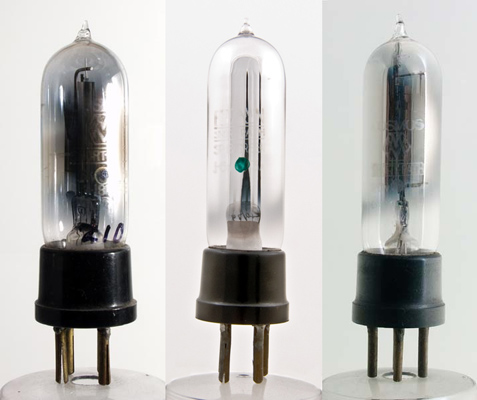|

Early Triode Valves
In the very earliest days it was reputed that, owing to the wide spread of characteristics, type labelling was carried out after testing. Thus, RF valves, detectors, and AF valves had their identifying coloured rings or caps painted on their bulbs after leaving the production line. They were then tested and sorted, where-upon the colours were applied to indicate the application for which they might prove to be most suitable.
With the advance of manufacturing techniques, characteristic spread came much more under control, although careful selection could still add materially to the performance of a multi-valve receiver. A choice of valves with 2, 4, or 6 Volt filaments was available and, at about the time of the period under review (early 1920's), the range was increased by the development and introduction of the thoriated tungsten filament. This resulted in an appreciable reduction in the power consumed by a multi-valve receiver. Nevertheless, battery consumption was still a major item in running costs, and the amount of space occupied by the necessary accumulator and HT battery required an extensive 'battery compartment' in receivers for home use. Whilst these items, together with their connecting wires, were not out of place in the amateurs den they were apt to excite comment from the ladies if they appeared on the top of the grand piano.
A division of interest was also beginning to appear amongst 'listeners' or 'listeners-in', as people with broadcast receivers were referred to at the time. The status of the 'listener-in' was apt to be judged by the number and distance of the stations that he could receive, rather than by the quality of the reception. This was on rather a different plane to the experimental work which was being carried out by the real enthusiast in long distance reception, this being work which did, in fact, add materially to the development of long distance communications. But the variety and excellence of BBC broadcasts were providing an ever-growing interest in quality of reception. This was all to the good for the future of the industry, since there was a hard core of musical talent who refused to broadcast after hearing how the efforts of others were reproduced.
During this period it was frequently suggested, not without a grain of truth, that good quality reception could only be obtained by using a crystal set and a pair of headphones. More than ten years later, this opinion was still quite strongly held by numbers of people. The frequency limitations of the early loudspeakers and inter-valve transformers certainly resulted in a complete loss of bass and treble, but a more serious cause of objectionable distortion was the overloading of the AF valves as the batteries ran down.
Batteries were still in use for the HT supply despite the fact that a mains supply was available in most houses. In fact, the earliest substitute for h.t. batteries were rotary converters. These were known as ML converters and were driven from the 6 Volt accumulator used to supply the filament current. An output of 120 Volts DC was available, and the metal box housing the converter also contained a smoothing circuit.
Some years later a 'battery eliminator' was put on the market. This was for use with AC mains only, and it included a mains transformer and smoothing circuits. An attempt to reduce the number of journeys necessary to take the accumulator to be recharged was made by marketing a 'trickle charger' which could be left more or less permanently connected to the mains supply and the accumulator. Both these pieces of equipment were rather costly and they required much more space than was usually available in the cabinet of the receiver. If fitted externally they were not inclined to improve the appearance of the room in which the receiver was located. It was not until 1928 that the first indirectly-heated 'mains' valves appeared and some two further years elapsed before these were really established and in general use for broadcast reception. 'Getting rid of the hum' then became a major exercise for the radio constructor.
|